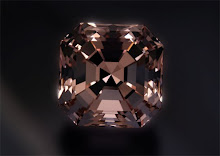Antsirabe, historically, was the hub of gem trade in Madagascar. But today it is relegated to third place behind Tana (where most anything can be acquired) and then Illakaka - where it is primarily about corundum, though other items show up as well.

Yes, it started out a leisurely path, then 2.5 hours later.

The hills surrounding Antsirabe are rippled with outcroppings - and this is currently where the majority of Madagascar’s Tourmaline is mined. The area surrounding the village of Ibity [pronounced “Ibeet”], roughly 30 kilometers outside of Antsirabe, is the source of anything worthwhile. And so that’s where we were headed today.

The area is peppered with hills all winding their way to about 6,000 feet where the mining is taking place.

From where the road ended where we left our vehicle, it was just over 2.5 hours hiking time. Some of the hiking was over indented double-tracks into the high grass, left behind by four-wheel drive vehicles. But most of the track was a bit more rustic....

Upon arrival we were greeted by about 40 workers, mostly men but a few women as well. With the water source in the valley below, this is all hard rock mining. Let me be clear, this is difficult work.

Generally, they are working in teams with either 2, 3 or 4 miners. A circular hole is dug roughly a meter or so across and this is their working space.

Then they begin the hard work following a seam into the earth. Some of the pits were as much as 30 meters deep. For the deeper pits, there would be a crudely constructed hand/rope/wood wench used to lower a person to the latest working depth, as seen here.

Difficult to make out in the photo below, but there is a miner being lowered into the shaft.

These miners were carrying their hand-made sieve boxes to the site. It appeared to us the mining crews took their tools with them each morning and night - probably to prevent poaching of their sites.


As gravels were revealed in the open pits using their hand tools, a reinforced style plastic bag or sack was lowered to the men in the pit. They shoveled the dirt and all it contained into the sack and then it was raised by rope to the surface.

They would dump the sack into hand fabricated sieves with rudimentary frames to hold the screen. This probably as low tech as it gets.

Once sieved, the crystal fragments or other potential workable items are set aside [that is, if there are any]. The balance of the diggings are dropped to another area that may have already been worked. Not exactly well executed re-claiming of the land, but this is better than what I witnessed in Namibia.

We visited with the miners for over an hour while we shared water bottles and viewed whatever rough they were willing to display. They allowed us to take some photos and then we headed back to Antsirabe. With roughly five hours total hiking time over difficult terrain, 6,000 feet elevation, warm temperatures and no cloud cover - we were burned out. Definately time for a shower, and maybe a beer or two.

No comments:
Post a Comment